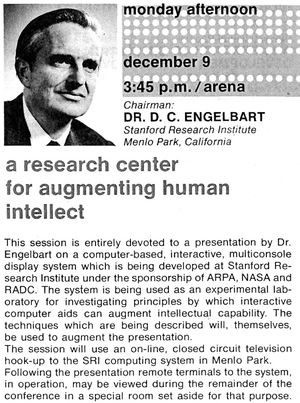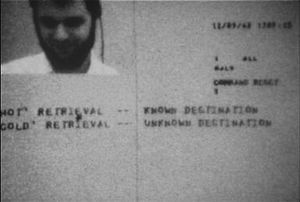We are still actively working on the spam issue.
Difference between revisions of "The Mother of All Demos"
(Create stub) |
(Wikify Hypertext) |
||
| (4 intermediate revisions by the same user not shown) | |||
| Line 1: | Line 1: | ||
| − | '''The Mother of All Demos''' is a colloquial name given to a presentation from 1968 for the NLX Machine by | + | {{stub}} |
| + | [[File:Dce1968conferenceannouncement.jpg|thumb|right|alt="An event poster from 1968|The announcement for the 1968 conference, it is billed as "A Research Center for Augmenting Human Intellect"]] | ||
| + | |||
| + | '''The Mother of All Demos''' is a colloquial name given to a presentation from 1968 for the NLX Machine by Douglass Engelbert. It was fundamentally a realization of the Memex machine by Dr. Vannever Bush in his famous essay ''As We May Think''. It introduces numerous concepts now standard to computing, including [[Hypertext]], using a mouse (years before Xerox), telecommunications, wireless networking, versioning, and several other things. | ||
| + | |||
| + | [[File:On Line System Videoconferencing FJCC 1968.jpg|thumb|left|alt="A black and white still from the presentation"|Demonstrating early attempts at Videoconferencing and Collaborative-editing during the presentation]] | ||
| + | |||
| + | It is widely considered one of the most significant events in the history of the development of the computer. | ||
| + | |||
| + | ==External links== | ||
| + | *[http://www.dougengelbart.org/firsts/dougs-1968-demo.html Memorial website] | ||
| + | *[https://archive.org/details/motherofalldemos_reel1 The Mother of All Demos Reel 1] | ||
| + | *[https://archive.org/details/motherofalldemos_reel2 The Mother of All Demos Reel 2] | ||
| + | *[https://archive.org/details/motherofalldemos_reel3 The Mother of All Demos Reel 3] | ||
Latest revision as of 06:49, 14 November 2020
The Mother of All Demos is a colloquial name given to a presentation from 1968 for the NLX Machine by Douglass Engelbert. It was fundamentally a realization of the Memex machine by Dr. Vannever Bush in his famous essay As We May Think. It introduces numerous concepts now standard to computing, including Hypertext, using a mouse (years before Xerox), telecommunications, wireless networking, versioning, and several other things.
It is widely considered one of the most significant events in the history of the development of the computer.

